Results 401 to 410 of 10762
LinkBacks (?)
-
12-26-2016, 11:32 AM
-
09-02-2016, 05:39 PM
-
whole garden made with pallets!! Love it!! | Pallets | Pinterest | Pallets, Pallets Garden and Wooden Pallets
Refback This thread03-06-2016, 11:30 AM -
10-20-2015, 05:29 PM
-
06-12-2015, 08:00 PM
-
02-26-2015, 01:58 PM
-
01-05-2015, 04:13 PM
-
12-19-2014, 10:19 AM
-
EMERGENCY: HUGE FEMA PANDEMIC EXERCISE IN USA IN NOVEMBER, INTERNET SHUT DOWN PART OF EXERCISE | Prepare4Survival
Refback This thread12-03-2014, 10:39 PM -
Off Grid World ? Ugly Duckling Shipping Container Home Built by Artist Is a Beautiful Swan on the Inside
Refback This thread11-25-2014, 03:10 PM -
11-17-2014, 10:59 PM
-
11-13-2014, 11:18 AM
-
11-09-2014, 02:54 PM
-
10-28-2014, 11:38 PM
-
10-26-2014, 05:54 AM
-
10-16-2014, 11:28 AM
-
10-03-2014, 01:25 PM
-
10-02-2014, 09:16 PM
-
09-26-2014, 07:00 PM
-
09-26-2014, 01:56 PM
-
09-19-2014, 04:46 PM
-
09-13-2014, 05:49 AM
-
09-05-2014, 01:52 PM
-
09-01-2014, 09:39 AM
-
08-30-2014, 06:29 PM
-
08-10-2014, 06:29 AM
-
08-04-2014, 05:07 PM
-
07-23-2014, 11:14 AM
-
New Evidence on Expiration Dates | Medical Preparedness | Doom and Bloom (TM) | Doom and Bloom (TM)
Refback This thread07-22-2014, 10:10 AM -
07-18-2014, 08:37 PM
-
07-15-2014, 04:57 PM
-
07-11-2014, 01:40 AM
-
04-22-2014, 11:14 AM
-
04-18-2014, 12:57 PM
-
04-18-2014, 10:10 AM
-
04-14-2014, 12:18 AM
-
04-12-2014, 02:28 AM
-
03-02-2014, 11:43 PM
-
12-24-2013, 11:59 PM
-
12-07-2013, 11:04 PM
-
kitchen | Cob
Refback This thread11-25-2013, 03:24 PM -
10-22-2013, 10:25 PM
-
Apple Pie Braid | Sweets
Refback This thread09-26-2013, 07:58 AM -
09-02-2013, 04:44 PM
-
5 Reasons Why You May have to Bug Out Even Though You Don’t Want to | The Apartment Prepper's Blog
Refback This thread08-23-2013, 03:20 PM -
06-27-2013, 06:30 AM
-
06-23-2013, 08:11 PM
-
06-17-2013, 11:21 PM
-
05-24-2013, 05:06 PM
-
To Eat / BASIC LIST / SUGGESTED ITEMS FOR LONG TERM SURVIVAL - Page 275 - ALIPAC
Refback This thread05-01-2013, 03:49 AM
Thread Information
Users Browsing this Thread
There are currently 1 users browsing this thread. (0 members and 1 guests)
-
12-06-2010, 04:34 PM #401Senior Member


- Join Date
- May 2007
- Location
- South West Florida (Behind friendly lines but still in Occupied Territory)
- Posts
- 117,088
How To Store Bulk Foods
December 6, 2010 by Peggy Layton
 Last time we talked about dehydrated foods. This week we’re going to discuss the best ways to store your bulk foods.
Last time we talked about dehydrated foods. This week we’re going to discuss the best ways to store your bulk foods.
First, select only the best food grade containers that will exclude light, oxygen and moisture. This will greatly extend the shelf life of your food. The best storage containers are the No. 10 double enamel gallon-sized cans and the food grade plastic buckets. However, you may also store food in canning jars with tight-fitting lids as well as heavy plastic containers such as soda bottles and apple juice, Gatorade and fruit juice containers. Plastic or glass gallon-size jars and Rubbermaid® type containers with lids work well also. The stackable containers will save space.

No. 10-Size Double Enamel
The No. 10-size cans hold approximately one gallon and are ideal for smaller quantities of food. You can purchase plastic lids to put on the cans after they are opened.
Most food storage companies use these types of containers. They are nitrogen-packed with an oxygen absorber packet sealed inside the can. These packets absorb free oxygen from the air around them and chemically bind it. This removes the oxygen from inside the can, which helps prevent insects from hatching or even living. This also prevents rancidity from occurring.
The atmosphere inside the can is mostly nitrogen, which is ideal for long-term storage of foods. If the oxygen level is below 2 percent, the food will stay good for a lot longer. You can order a wide variety of dehydrated and freeze-dried foods that are packed in the No. 10 cans with an oxygen absorber in the can. They are packed for long-term storage and are ready to go in a heavy cardboard box that holds six cans and stacks on top of each other. To see the many different foods available go to my website.
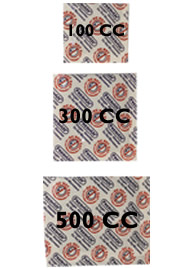 Oxygen Absorber Packets
Oxygen Absorber Packets
The oxygen absorber packets look like a tea bag or sugar packet. This method is a relatively new procedure and is proving to be one of the best ways to keep foods fresh. They must be used up within 15 minutes of being opened and exposed to the air.
These packets absorb the oxygen from the container and trap it in an iron powder, salt and moisture mixture. This is the safest way to remove oxygen. These oxygen packets can be purchased from my website.
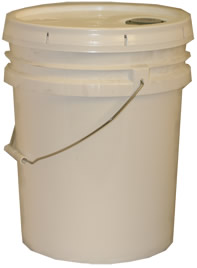
5- or 6-Gallon Plastic Buckets Or Pails
These buckets have tight-fitting lids with rubber gaskets. They are ideal for large quantities of grains, beans, legumes, sugar, flour, etc.
You can purchase an inner liner that is made from a metallized foil, which will keep the light from harming the food and causing it to deteriorate. It also acts as a moisture barrier and keeps rodents out. The bucket with a metallized liner, when sealed properly with a tight-fitting lid, is a very good method of storing food.
To seal the Mylar® liner, line the bucket with the bag and use one oxygen absorber packet per gallon of grain, beans, dried food, etc. Pour one gallon of dried food or grain in the bucket, then add an oxygen absorber, add another gallon of food or grain and continue until the bucket is full. Then get out as much air as possible. Lay the bag as flat as you can. The bag will be much taller than the bucket.
You can use an iron to heatseal the end of the bag. This way you can use the bag over and over again. Pierce a hole in the corner of the bag and hold the bag below the seal so you don’t suck up the contents of the bag. Suck all the air out with the hose or a smaller attachment to the vacuum that can be inserted into the end. When the air is sucked out and the bag looks vacuum-packed, hold the end and seal it with an iron. Do not let air back into the bag.
Note: Never use buckets that have contained chemicals, paint, Sheetrock™ mud or kitty litter, etc. Restaurant food grade containers are ok; wash them well and rinse with bleach and water.

Gama Lids for 5-gallon buckets
There are special lids available for 5-gallon buckets that have a center section that screws on and off. It makes it nice to open and close the lids when using bulk foods on an everyday basis. I use these lids and love them.
I keep my buckets of wheat, rice, beans, pasta, etc. handy so I can use out of them every day. I also keep a smaller container of these products in my kitchen cupboard, so when I run out I just fill it up from the bucket. The buckets are stored in my pantry.
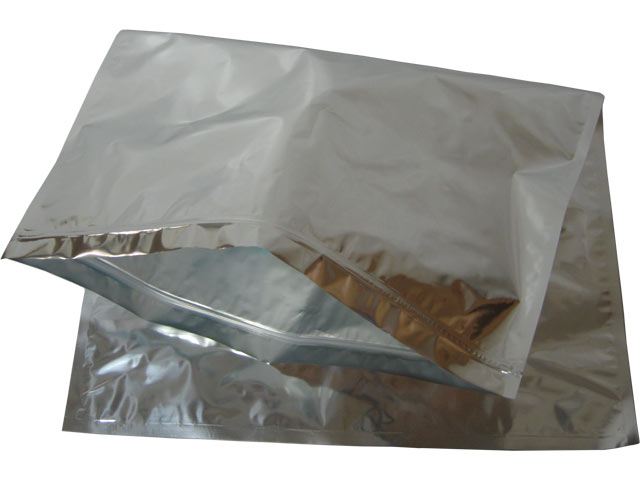
Mylar® Bags
The ones previously mentioned can be purchased from my website. [link www.peggylayton.com] The heaviest Mylar® bags in the large size are the best for lining the buckets. The bag can be sealed with a hot iron. Oxygen packets can be inserted before sealing. However, I have stored a lot of food in buckets without Mylar liners.
As long as the buckets are sealed properly, they will be just fine. If I know that I am going to sprout the beans, legumes or grain, I do not put an oxygen absorber in the can or bucket. Lack of oxygen will kill the enzymes that are alive in the kernel and they won’t sprout. I will talk about the importance of sprouting in another article.
Methods For Storing Grains
Bay Leaves Method: An alternative to using oxygen absorbers is to use bay leaves. They can be spread throughout the container or food or grain. Use two bay leaves for small amounts up to one gallon, or five leaves in the 5-gallon buckets. It keeps the weevils and other bugs out, because they don’t like the smell of bay leaves.
Freezing Grain Method: If your buckets of grain are placed in the garage for the winter, the freezing temperatures will probably kill any weevil that is present. You can also deep-freeze grain in 10-pound bags and leave it for a week to kill the bugs.
Diatomaceous Earth Method: Diatomaceous earth (DE) can be mixed into your stored grains and beans to control insects without having to remove the dust before consuming it. For every 40 pounds of grain or beans, you mix in one cup of DE with it. Coat every kernel and mix it in small batches. Cover your mouth so you don’t breathe the dust in, as it can irritate your lungs.
The DE you want to use is sold as an organic garden insecticide. There are several different types of DE. Make sure you get the kind that is approved for human consumption and not the swimming pool type. You can find DE at places like home and garden stores and Intermountain Farmers Association stores.
The Causes of Deterioration
Oxygen: Oxygen is the one thing that will rob the nutritive value from the food. All living food contains enzymes which when exposed to oxygen start to break down. The nutritive value is lost, little by little, as it breaks down. That is why it is very important to remove the oxygen from the containers before you package them. It’s also good to store grains as a whole grain rather than a cracked grain. Once the kernel is cracked, it dies and the rancidity process begins. Grain will store much longer in its whole grain form.
Bacteria: Bacteria, yeast and molds are controlled by processing, canning, dehydrating, drying, freezing, etc. Bacteria is the most common cause of spoilage, so it’s important to keep all food properly processed. Once beans, meat, vegetables, etc. are opened, they must be used up quickly to prevent spoilage. Once I open dried eggs, I like to keep them in the refrigerator in quart jars with lids so no moisture gets into the bottles. A rule of thumb is to use any can of dehydrated food within one year of opening it.
Insects: Insects grow in food (and especially anything made with grains such as flour) because the eggs or larvae are already in the product before you package it. The rodents deposit their waste product in the food and eat it as they reproduce. Again the oxygen absorbers will remove the oxygen and prevent insects from living. Lack of oxygen kills bugs and larvae.
Shelf Life: Rotate your food and use it within the estimated period of time determined by research done on each product. There is a shelf life chart in my books; Food Storage 101, Where Do I Begin? and Emergency Food Storage and Survival Handbook.
When the food is stored too long, two things happen:
• The nutritional value breaks down.
• The color, flavors, texture and smell change and people will not eat it.
Light
As you find containers for your bulk food, try to get containers that are dark and cannot be permeated by light. The two most common containers that allow light in are glass jars and plastic buckets or bottles. If these are used, they need to be stored in heavy cardboard boxes in a dark room.
Humidity And Moisture: Dehydrated foods store well when the moisture is removed. The moisture levels of dehydrated food should be less than 10 percent. The food will be hard, not leathery. Be sure to keep all containers up off the floor and away from anything that is high in humidity like dryer vents, water heaters or anything that could flood and damage the food or rust out the cans.
Temperature And Location
A cool dark place is a must. The temperature of the room should stay constant throughout the year. Find the coolest place in the house — usually it’s a basement, if you have one.
Try to find a place that stays between 45-65 degrees Fahrenheit year-round. I know this is impossible in climates where the temperature fluctuates from season to season, but the lower the temperature, the longer the shelf life. However, you want to stay 10 to 20 degrees above freezing. Most basements are between 60 and 70 degrees Fahrenheit and will cut the shelf life down a little.
If you store your food in a garage or shed where the temperature fluctuates, you can cut the shelf life down even more. Where I live it is popular to have a cold storage room located in a basement and built under a porch. Usually it has a dirt floor, which maintains a cooler temperature. My husband built us a root cellar that is well-insulated and stays a constant temperature year-round.
eFoods Global
A company that I recommend for fast, easy, nutritious gourmet meals that will store for up to 15 years is eFoods Global. This is a new concept in storable foods that are delicious, nutritious, affordable and convenient for daily use. If you would like to try the same six meals that I received, simply go to http://peggylayton.myefoods.com, watch the three-minute video and then click on the WIN button. After you receive your six meals for $9.95, you can order a shipment of food to be delivered to you once per month. This is more cost-effective, and over a few month’s time you will have enough good-tasting nutritious meals stored for an emergency.
Food storage 101, “Where Do I Begin?” and many other books may be purchased on my website, www.peggylayton.com. You can also contact me via email or by phone: 435-835-0311.
http://www.personalliberty.com/survi...re-bulk-foods/Last edited by AirborneSapper7; 02-01-2012 at 09:24 AM.
Join our efforts to Secure America's Borders and End Illegal Immigration by Joining ALIPAC's E-Mail Alerts network (CLICK HERE)
-
12-10-2010, 03:45 AM #402Senior Member


- Join Date
- May 2007
- Location
- South West Florida (Behind friendly lines but still in Occupied Territory)
- Posts
- 117,088
Five Different Shelf Life Studies: Two on Canned Food and Three on Dry Food
Summary Article © Copyright 2007,2010 by Robert Wayne Atkins, P.E.
The following brief summaries are for fair use and educational purposes only.
Publication History:
Canned Food Study One
A Food and Drug Administration Article about a shelf life test that was conducted on 100-year old canned foods that were retrieved from the Steamboat Bertrand can be read at the following link:
http://web.archive.org/web/200705091.../CON00043.html
Following is a brief summary of a very small portion of the above article:
"Among the canned food items retrieved from the Bertrand in 1968 were brandied peaches, oysters, plum tomatoes, honey, and mixed vegetables. In 1974, chemists at the National Food Processors Association (NFPA) analyzed the products for bacterial contamination and nutrient value. Although the food had lost its fresh smell and appearance, the NFPA chemists detected no microbial growth and determined that the foods were as safe to eat as they had been when canned more than 100 years earlier. The nutrient values varied depending upon the product and nutrient. NFPA chemists Janet Dudek and Edgar Elkins report that significant amounts of vitamins C and A were lost. But protein levels remained high, and all calcium values 'were comparable to today's products.'"
"NFPA chemists also analyzed a 40-year-old can of corn found in the basement of a home in California. Again, the canning process had kept the corn safe from contaminants and from much nutrient loss. In addition, Dudek says, the kernels looked and smelled like recently canned corn."
"According to a recent study cosponsored by the U.S. Department of Agriculture and NFPA, canned foods provide the same nutritional value as fresh grocery produce and their frozen counterparts when prepared for the table. NFPA researchers compared six vegetables in three forms: home-cooked fresh, warmed canned, and prepared frozen. 'Levels of 13 minerals, eight vitamins, and fiber in the foods were similar,' says Dudek. In fact, in some cases the canned product contained high levels of some vitamins that in fresh produce are destroyed by light or exposure to air."
Canned Food Study Two
A canned food shelf life study conducted by the U.S. Army revealed that canned meats, vegetables, and jam were in an excellent state of preservation after 46 years.
The Washington State University summary article can be read at:
http://www.whatcom.wsu.edu/family/facts/shelflif.htm
Dry Food Study One
A scientific study conducted at Brigham Young University on the shelf life of a variety of different dry foods can be read at both of the following links:
http://ce.byu.edu/cw/womensconferenc...ns/pdf/52a.pdf
http://www.providentliving.org/conte...4222-1,00.html
A brief summary of the above web site information shows the following estimated shelf life per dry food item:
Over 30 years for wheat and white rice.
30 years for pinto beans, macaroni, rolled oats, and potato flakes.
20 years for powdered milk.
All dry food items should be stored in airtight moisture proof containers at a temperature between 40ºF to 70°F.
Salt, baking soda, and granulated sugar still in their original containers have no known shelf life limit if properly stored.
Dry Food Study Two
http://www.sciencedaily.com/videos/2..._for_years.htm
Following are some direct quotes taken from the above web site:
Food scientists now know that, when properly sealed, some dried food that's been sitting on shelves for years, could still be OK to eat.
"It lasts a lot longer than we thought," Oscar Pike a food scientist at Brigham Young University in Provo, Utah, tells DBIS.
Scientists have known certain foods like sugar and salt can be stored indefinitely, but wanted to learn the shelf life of other food like dried apples -- stored since 1973 -- tried by taste testers.
"I like to call it the emergency shelf life of the food, food that you'd still be willing to eat in an emergency," Pike says. "It's not as though it were freshly canned, but it's certainly edible."
He says the best foods to store are low in moisture, like wheat and powered milk. But keep all foods away from heat and light to stop it from going stale and losing nutritional value. "All the foods that we've tested have been stored at room temperature or below, so you want to avoid attic and garage storage."
In the study, researchers taste-tested rolled oats that had been stored in sealed containers for 28 years. Three-fourths of tasters considered the oats acceptable to eat in an emergency.
Dry Food Study Three
http://beprepared.com/article.asp?ai...cd2=1213479534
Following are some quotes taken from the above web site:
It is important to first identify what is meant by "food storage" and "shelf life." "Food storage" that is intended to be held long-term is generally considered to be low moisture food packed in either #10 cans or in metalized bags placed within large buckets. "Shelf life" can be defined in the following two ways:
"Best if used by" shelf life - Length of time food retains most of its original taste and nutrition.
"Life sustaining" shelf life - Length of time food preserves life, without becoming inedible.
There can be a wide time gap between these two definitions. For example, most foods available in the grocery store that are dated have a "Best if used by" date that ranges from a few weeks to a few years. On the other hand, scientific studies have determined that when properly stored, powdered milk has a "Life sustaining" shelf life of 20 years. That is, the stored powdered milk may not taste as good as fresh powdered milk, but it is still edible.
Shelf life is extremely dependent on the following storage conditions:
Temperature: Excessive temperature is damaging to food storage. With increased temperature, proteins breakdown and some vitamins will be destroyed. The color, flavor and odor of some products may also be affected. To enhance shelf life, store food at room temperature or below; never store food in an attic or garage.
Moisture: Excessive moisture can result in product deterioration and spoilage by creating an environment in which microorganisms may grow and chemical reactions can take place.
Oxygen: The oxygen in air can have deteriorative effects on fats, food colors, vitamins, flavors, and other food constituents. It can cause conditions that will enhance the growth of microorganisms.
Light: The exposure of foods to light can result in the deterioration of specific food constituents, such as fats, proteins, and vitamins, resulting in discoloration, off-flavors, and vitamin loss.
EXAMPLES OF SHELF LIFE:
Recent scientific studies on dehydrated food have shown that food stored properly can last for a much longer period of time than previously thought. This research determined the "life sustaining" shelf life to be the following:
Dry Food Item Shelf Life Wheat, White Rice, and Corn 30 years or more Pinto Beans, Apple Slices, Macaroni 30 years Rolled Oats, and Potato Flakes 30 years Powdered Milk 20 years
http://www.grandpappy.info/hshelff.htmLast edited by AirborneSapper7; 02-01-2012 at 09:26 AM.
Join our efforts to Secure America's Borders and End Illegal Immigration by Joining ALIPAC's E-Mail Alerts network (CLICK HERE)
-
12-12-2010, 04:06 AM #403Senior Member


- Join Date
- May 2007
- Location
- South West Florida (Behind friendly lines but still in Occupied Territory)
- Posts
- 117,088
4 Types of Base Camps and When to Use Them
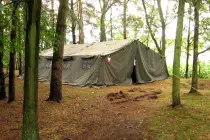
Choosing the type of base camp you need is dependent on your gear and the current situation. Here are four types of survival base camps I have open to myself that range from overnight emergency cache to permanent defensible shelter.
Article by Survival Cache contributing author Chuck
1. Nomad This style base camp is better for groups who pick a remote spot, set up tents/shelters and have a small community. Some even go as far as one big tent for a meeting place and the families then have smaller ones for their homes. The Nomad camp can be erected in little time from start to finish; it takes about two hours to set up and break down. We found a great product – Family Survival Shelters that are perfect for large groups.
This style base camp is better for groups who pick a remote spot, set up tents/shelters and have a small community. Some even go as far as one big tent for a meeting place and the families then have smaller ones for their homes. The Nomad camp can be erected in little time from start to finish; it takes about two hours to set up and break down. We found a great product – Family Survival Shelters that are perfect for large groups.
- Advantages: Speed, Community
- Disadvantages: Difficult to defend, Not permanent
 The bunker is harder because you must to have land to make it a permanent shelter that is hidden from everyone but you and your group. It is difficult to build this style of shelter without everyone knowing unless you have land that is far off the beaten path. It can also cost a lot to make and keep up with.
The bunker is harder because you must to have land to make it a permanent shelter that is hidden from everyone but you and your group. It is difficult to build this style of shelter without everyone knowing unless you have land that is far off the beaten path. It can also cost a lot to make and keep up with.
Some people choose this style because it is much easier to hide. The bunker is also the most defensible type of base camp with limited entrances and advantageous positions.
- Advantages: Fortified, very Defensible, Can be Hidden
- Disadvantages: Difficult to Build, Can be Expensive, Usually need your own land
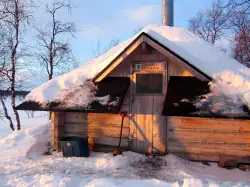 This style base camp is great, once again, if you have land off the beaten path and just want to get out before the SHTF. The permanent base camp may be just like a home with walls and a roof. It’s a lot like a cabin many outdoorsmen have for their hunting trips. Ideally it is not hard to get to, but not right out in the open for the whole world to see either. Overall, it is easier to build, but harder to hide than the bunker.
This style base camp is great, once again, if you have land off the beaten path and just want to get out before the SHTF. The permanent base camp may be just like a home with walls and a roof. It’s a lot like a cabin many outdoorsmen have for their hunting trips. Ideally it is not hard to get to, but not right out in the open for the whole world to see either. Overall, it is easier to build, but harder to hide than the bunker.
- Advantages: Good protection from the elements, fairly defensible
- Disadvantages: Expensive, not easily hidden, need your own land
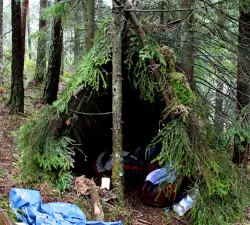 This one is usually found near a survival cache. It’s a spot where all the basics are covered like shelter, weapons, 3 days worth of food, and water gathering materials. You make this camp in preparation of moving to a better more permanent location soon. They are great for those of us that like being able to Bug Out quickly without a second thought.
This one is usually found near a survival cache. It’s a spot where all the basics are covered like shelter, weapons, 3 days worth of food, and water gathering materials. You make this camp in preparation of moving to a better more permanent location soon. They are great for those of us that like being able to Bug Out quickly without a second thought.
- Advantages: Very quick to set up, easily hidden, cheap,
- Disadvantages: temporary, not easily defended, limited supplies
I am sure there are other types that I am missing but these are the first few that come to mind when thinking about TEOTWAWKI. If you have any other kinds of survival camps let us know. I am always open to suggestions.
Visit Our New Survival Gear Store – Forge Survival Supply
http://survivalcache.com/survival-base-camp-types/Last edited by AirborneSapper7; 02-01-2012 at 09:27 AM.
Join our efforts to Secure America's Borders and End Illegal Immigration by Joining ALIPAC's E-Mail Alerts network (CLICK HERE)
-
12-12-2010, 04:17 AM #404Senior Member


- Join Date
- May 2007
- Location
- South West Florida (Behind friendly lines but still in Occupied Territory)
- Posts
- 117,088
The Book This Site Is Based On

Wilderness Survival
1. Introduction
2. Psychology of Survival
3. Survival Kits and Planning
4. Survival Medicine
5. Shelters
6. Water Procurement
7. Firecraft
8. Food Procurement
9. Survival Use of Plants
10. Poisonous Plants
11. Dangerous Animals
12. Weapons, Tools, Equipment
13. Desert Survival
14. Tropical Survival
15. Cold Weather Survival
16. Sea Survival
17. Water Crossings
18. Wilderness Navigation
19. Signaling Techniques
20. Hostile Areas
21. Camouflage
22. Contact With People
23. Survival in Man-Made Hazards
- Survival Reference
A. Survival Kits
B. Edible and Medicinal Plants
C. Dangerous Plants
D. Dangerous Insects and Spiders
E. Poisonous Snakes and Lizards
F. Dangerous Fish and Mollusks
G. Clouds: Foretellers of Weather
H. Shelters, Shacks, and Shanties
+ Mountain Survival
+ Disaster Planning
Self Sufficiency
+ How to Raise Chickens
+ Composting
- Training Network
Fitness Training
Orienteering
http://www.wilderness-survival.net/Last edited by AirborneSapper7; 02-01-2012 at 09:28 AM.
Join our efforts to Secure America's Borders and End Illegal Immigration by Joining ALIPAC's E-Mail Alerts network (CLICK HERE)
-
12-12-2010, 04:49 AM #405Senior Member


- Join Date
- May 2007
- Location
- South West Florida (Behind friendly lines but still in Occupied Territory)
- Posts
- 117,088
Genuine US Military Issue
Canteen, Cup and Stove Survival Unit (US Integral Survival Unit)
The US Integral Survival Unit, which includes the Military GI Issue Plastic Canteen, the Military Issue Stainless Steel Canteen Cup, the Military Issue Heavy Duty Canteen Cup Stove, Type II, the new Canteen Cup Lid by Heavy Cover and Military Gel Fuel is the perfect survival cooking kit suitable for disaster or adventure.

Canteen, Cup and Stove (US Integral Survival Unit)

Military Gel Fuel

Canteen Cup Heavy Cover Lid

US Integral Survival Unit Holder (optional accessory)
http://www.bestglide.com/us_integral_survival_unit.htmlLast edited by AirborneSapper7; 02-01-2012 at 09:29 AM.
Join our efforts to Secure America's Borders and End Illegal Immigration by Joining ALIPAC's E-Mail Alerts network (CLICK HERE)
-
12-12-2010, 04:56 AM #406Senior Member


- Join Date
- May 2007
- Location
- South West Florida (Behind friendly lines but still in Occupied Territory)
- Posts
- 117,088
NATO Water Bottle Holder and Survival Medical Kit Pouch
The Zulu Holder was orignally designed as a NATO Water Bottle Holder and Crusader Integral Survival Unit Carrier. However, it did not take us long to realize that we had actually designed a great survival kit and medical kit holder. The Zulu Mark I was designed strong enough to carry the NATO Water Bottle, BCB Crusader Cup, BCB Crusader Cooker, and the Crusader Cup Lid in one convenient location. The complete unit fits snugly to limit movement or if you choose, insert only the NATO Water Bottle with room to spare.


NATO Water Bottle and Survival Kit Carrier
http://www.bestglide.com/nato_water_bottle_holder.htmlLast edited by AirborneSapper7; 02-01-2012 at 09:29 AM.
Join our efforts to Secure America's Borders and End Illegal Immigration by Joining ALIPAC's E-Mail Alerts network (CLICK HERE)
-
12-12-2010, 05:04 AM #407Senior Member


- Join Date
- May 2007
- Location
- South West Florida (Behind friendly lines but still in Occupied Territory)
- Posts
- 117,088
P-38 and P-51 Can Opener - Armys Greatest Invention
THE P-38 CAN OPENER

SIMPLICITY AT IT'S BEST.
CAN OPENER DIRECTIONS
Open blade. Place opener as shown in diagram. Twist down to puncture slot in can top inside rim.
Cut top by advancing opener with rocking mo-tion. Take small bites.
STERILIZE BEFORE RE-USE
Tie string through hole in opener to wash and ster-ilize with mess-gear if possible. When boiling water is unavailable, clean opener as thorough-ly as possible and hold cutting blade over a
match flame a few sec- onds immediately before use.
CLICK HERE FOR PRINTABLE
P-38 CAN OPENER DIRECTIONS
MODERN VERSION
Originally P-38s came in a brown Kraft paper wrapper with a diagram and directions how to use printed on it. Another purpose of the wrapper was to keep the P-38 clean before use. Afterward the used P-38 was expected to be thrown away as more P-38s were packed in with each case of C-Rations. At first a dozen P-38s came with each case but eventually only 3 or 4 were packed in a case because it was found that GIs were keeping the P-38s rather than being without one at chow time (read Rations in Korea note). Unopened P-38s still in the wrapper and still in good condition are getting much harder to find.
During the WWII, Korean and Vietnam Wars when hungry GI's were ready to dive into their delicious meals of K or C-Rations they used their trusty P-38s to open the cans. No it wasn't the famous WWII fighter plane or a German pistol, it was an amazingly simple little piece of 1-1/2 inch stamped metal that was developed in just 30 days during the Summer of 1942 by the Subsistence Research Laboratory in Chicago.It's official designation is 'US ARMY POCKET CAN OPENER' or 'OPENER, CAN, HAND, FOLDING, TYPE I', but it is more commonly know by its nickname the P-38 which it supposedly acquired from the 38 Punctures required to open a C-Ration can. It is also known by many as a "John Wayne" by those in the Navy and Marines because he was shown opening a can of C-Rations using a P-38 in a WWII training film. From then on Sailors and Marines referred to them as a "John Wayne". Recently I received emails from two different Vets that referred to P-38s as 'Dead Dukes' after John Wayne's death.Originally P-38s came wrapped in brown Kraft paper packets with a diagram and directions how to use printed on it. About a dozen P-38s came packed in a case of C-Rations but because everyone was hoarding them eventually only 3 were included in a case (read Rations in Korea note). These handy gadgets have adorned the dog tag chains and key rings of WWII, Korean and Vietnam war vets ever since opening their first can of C-rats with one.I've heard stories about GIs holding C-Ration can opening races using P-38s which were usually won by one who could open a C-rat can in less time than it takes to read this sentence.In her famous article for 'The Pentagram' Army Public Affairs' Officer Maj. Renita Foster wrote the defining article about P-38s how they could be the Army's greatest invention ever. Most WWII, Korean and Vietnam era GIs would hardily agree.
(CLICK HERE FOR JPG OF 'ARMY'S GREATEST INVENTION' ARTICLE)(TEXT VERSION OF 'ARMY'S GREATEST INVENTION' ARTICLE)(MORE ARTICLES & STORIES BY RENITA FOSTER)
Renita Foster, Fort Monmouth Public Affairs has updated her famous P-38 article (click on link below):
http://www.army.mil/-news/2009/08/11...invention-ever
Unopened vintage P-38s in their original paper wrapper are getting much harder to find so resist the temptation to open one if you find it. They are becoming collector's items since more and more GIs are putting them in their military & medal displays, collections and to replace a lost beloved P-38. Also P-38 collections have become very popular lately as they don't cost much and don't take up much space. It's a lot of fun finding the hard to get P-38s.I've had the same US SPEAKER P-38 on my key-ring since my first Boy Scout camping trip when the Scoutmaster gave it to me. We used them to open the big cans of peaches for the delicious cobbler that he would make in a huge cast iron skillet over the campfire. We ate that delicious cobbler as we sat around the campfire just before crawling into our sleeping bags. I can even taste it now. My Scoutmaster was a WWII and Korean War veteran that knew how handy the little P-38s were and gave one to every new member of the Scout troop on their first camping trip.Recently P-38s have added a new role to their long list of uses. Shelters and organizations that aid the homeless hand them out and they were also included in some of the humanitarian relief packets dropped into Afghanistan. I've also been told they are being handed out here in the USA by relief organizations after natural disasters for when the power is out and electric can openers no longer work. A P-38 is a lesson in simplicity at it's best. Don't you wish everything in life could be as simple and useful as a P-38.
http://www.georgia-outfitters.com/page52.shtml
Last edited by AirborneSapper7; 02-01-2012 at 09:37 AM.
Join our efforts to Secure America's Borders and End Illegal Immigration by Joining ALIPAC's E-Mail Alerts network (CLICK HERE)
-
12-12-2010, 05:13 AM #408Senior Member


- Join Date
- May 2007
- Location
- South West Florida (Behind friendly lines but still in Occupied Territory)
- Posts
- 117,088
How to Make Your Outdoor Survival Kit

http://www.trails.com/how_3556_outdoor- ... l-kit.html
Any time you're out in the wilderness there is the possibility of something happening that will require you to be prepared to take care of yourself, When you're experiencing the great outdoors, it doesn't take much to turn a simple trip into a survival situation. Being prepared with some simple items can make all the difference in the world. Depending on what type of environment you are in, items can be added or subtracted from this basic homemade survival kit.
Instructions
Difficulty: Moderate
Things You’ll Need: Signaling Device, visual and auditory Multi purpose knife Fire starter-magnesium and strike anywhere matches Fire goop 50 to 100 feet of good quality cord Iodine tablets Compass and local map Space Blanket Two 40- to 50-gallon garbage bags Powerbars Flashlight Small pocket saw Aspirin or aspirin product Small first aid kit Pouch to keep items in
- Signaling Device, visual and auditory
- Multi purpose knife
- Fire starter-magnesium and strike anywhere matches
- Fire goop
- 50 to 100 feet of good quality cord
- Iodine tablets
- Compass and local map
- Space Blanket
- Two 40- to 50-gallon garbage bags
- Powerbars
- Flashlight
- Small pocket saw
- Aspirin or aspirin product
- Small first aid kit
- Pouch to keep items in
Step 1
Know the area and terrain in which you are going to be. This will allow you to customize your materials.
Step 2
Make a list of items you will need. Check local conditions, go over your equipment and verify that it is all in good condition.
Step 3
Assemble the gathered items and pack them in a bag that you can put in your daypack or knapsack. This kit will be ready for you to take with you on any trips in the future.
Step 4
Plan how you will handle situations before they arise. Run different scenarios and develop contingency plans. Being prepared mentally is important.
Step 5
Always let someone know where you are going and when you plan to return
http://www.trails.com/how_3556_outdo...vival-kit.htmlLast edited by AirborneSapper7; 02-01-2012 at 09:40 AM.
Join our efforts to Secure America's Borders and End Illegal Immigration by Joining ALIPAC's E-Mail Alerts network (CLICK HERE)
-
12-12-2010, 05:19 AM #409Senior Member


- Join Date
- May 2007
- Location
- South West Florida (Behind friendly lines but still in Occupied Territory)
- Posts
- 117,088
 Join our efforts to Secure America's Borders and End Illegal Immigration by Joining ALIPAC's E-Mail Alerts network (CLICK HERE)
Join our efforts to Secure America's Borders and End Illegal Immigration by Joining ALIPAC's E-Mail Alerts network (CLICK HERE)
-
12-12-2010, 05:35 AM #410Senior Member


- Join Date
- May 2007
- Location
- South West Florida (Behind friendly lines but still in Occupied Territory)
- Posts
- 117,088
DIAMOND STRIKE ANYWHERE MATCHES
http://www.combattactical.com/diamond-s ... 20687.htmlLast edited by AirborneSapper7; 02-01-2012 at 09:41 AM.
Join our efforts to Secure America's Borders and End Illegal Immigration by Joining ALIPAC's E-Mail Alerts network (CLICK HERE)


 226Likes
226Likes LinkBack URL
LinkBack URL About LinkBacks
About LinkBacks




 Reply With Quote
Reply With Quote


New York Post 270.4K Followers Supreme Court allows Trump admin...
10-03-2025, 09:46 PM in General Discussion